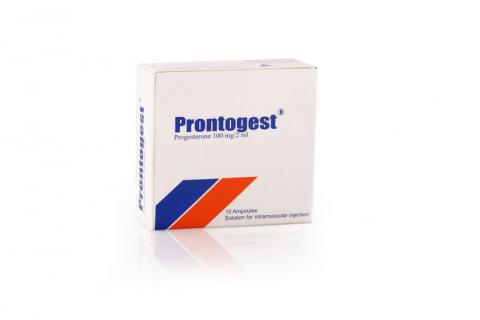Brand Name: Prontogest Ampoule
Active Ingredient: Progesterone
When is Prontogest Ampoule prescribed for?.
- Prontogest is indicated for the treatment of dysfunctional uterine bleeding.
- It is also indicated for the maintenance of early pregnancy in cases of documented history of 3 or more prior consecutive unexplained miscarriages and in selected cases as an adjunct to successful treatment of infertility with techniques such as in-vitro fertilisation (IVF) or gamete intra-fallopian transfer (GIFT) in order to facilitate uterine implantation of the fertilised ovum.
How should you take Prontogest Ampoule?
- Dysfunctional uterine bleeding:
5 - 10mg daily for 5 - 10 days until 2 days before anticipated onset of menstruation. - Maintenance of pregnancy:
Twice weekly or more frequent (maximum: daily) injections of 25-100 mg from approximately day 15, or day of transfer of embryo or gametes usually until 8 - 16 weeks of pregnancy when secretion of progesterone from the placenta should be established.
Daily dosage can be increased to 200mg at the discretion of the physician.
As the indications for Prontogest are restricted to women of child-bearing age, dosage recommendations for children
and the elderly are not appropriate.
Prontogest is given by intramuscular injection. It should be injected deep into the buttock, rather than the thigh or deltoid, using a 1.5 inch (3.8 cm) needle. This site has ample fat cells where a depot of progesterone can be formed for slow release.
When Prontogest Ampoule shouldn't be prescribed?
- Hypersensitivity to progestin.
- Undiagnosed vaginal bleeding.
- Missed or incomplete abortion.
- Mammary or genital tract carcinoma.
- Thrombophlebitis.
- Cerebral haemorrhage.
- Marked hepatic dysfunction.
- Contraindicated as a diagnostic test for pregnancy
Special warning and precautions with Prontogest Ampoule:
- Prontogest should be used cautiously in patients with conditions that might be aggravated by fluid retention (e.g. hypertension, cardiac disease, renal disease, epilepsy), with a history of mental depression, diabetes, mild to moderate hepatic dysfunction, acute intermittent porphyria, migraine or photosensitivity.
- If unexplained, sudden or gradual, partial or complete losses of vision, proptosis or diplopia, papilloedema, retinal vascular lesions or migraine occur during therapy, the drug should be discontinued and appropriate diagnostic and therapeutic measures instituted.
Special information if you are pregnant or breastfeeding
- Prontogest may be used to maintain pregnancy where there is deficient production of endogenous progesterone from the corpus luteum. It should not be necessary to administer Prontogest once there is adequate secretion of placental progesterone. Prontogest contains progesterone itself, the same as the naturally secreted hormone, and is not associated with masculinisation of a female foetus as are synthetic progestin.
- Detectable amounts of progesterone enter the breast milk. As the effect on the suckling infant has not been determined, the use of Prontogest during lactation is not recommended.
Possible Side effects with Prontogest Ampoule:
- Breakthrough bleeding, Change in menstrual flow, Amenorrhoea, Changes in cervical erosion and secretions.
- Breast changes, Oedema, Weight gain, Catabolism.
- Cholestatic jaundice.
- Allergic reactions and rashes, Acne, Local reactions at site of injection.
- Chloasma.
- Mental depression, pyrexia, insomnia, somnolence.
- Nausea, alopecia.
- Hirsutism.
Possible Drug interaction with Prontogest Ampoule:
- Prontogest may interfere with the effects of bromocriptine. Prontogest may affect the results of laboratory tests of hepatic and/or endocrine functions.
- Prontogest may raise the plasma concentration of cyclosporin.

